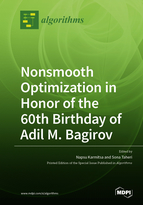Nonsmooth Optimization in Honor of the 60th Birthday of Adil M. Bagirov
A special issue of Algorithms (ISSN 1999-4893). This special issue belongs to the section "Analysis of Algorithms and Complexity Theory".
Deadline for manuscript submissions: closed (30 June 2020) | Viewed by 27058
Special Issue Editors
Interests: nonsmooth optimization; large-scale optimization; machine learning
Special Issues, Collections and Topics in MDPI journals
Interests: nonsmooth optimization; data mining; machine learning
Special Issues, Collections and Topics in MDPI journals
Special Issue Information
Dear Colleagues,
Nonsmooth optimization (NSO) refers to the general problem of minimizing (or maximizing) functions that have discontinuous gradients. These types of functions arise in many applied fields, for instance, in image denoising, optimal shape design, computational chemistry and physics, machine learning, and data mining including cluster analysis, classification and regression. In most of these applications NSO approaches lead to a significant reduction in the number of decision variables in comparison with any other approaches, and thus facilitate the design of efficient algorithms for their solution. In addition, various real-world problems can be modeled more realistic as an NSO problem; the robust formulation of a system may lead to solving an NSO problem; and even solving a difficult smooth (continuously differentiable) problem sometimes requires the use of NSO techniques in order to either reduce the problem’s size or simplify its structure. These are some of the main reasons for the increased attraction to nonsmooth analysis and optimization during the past few years. Despite the considerable developments in NSO, the lack of numerically effective methods is still evident and their applications to real-world problems is somewhat limited. The aim of this Special Issue is to collect together the most recent techniques and applications in the area of NSO.
We invite you to submit your original and unpublished research papers to the Special Issue on nonsmooth optimization. We have a special interest in research works focusing on various new NSO algorithms including those applying the special structure of nonsmooth problems (DC, partial smoothness, sparsity, etc.) and the applications of NSO including (but not limited to) image denoising, machine learning, and data mining
Dr. Napsu Karmitsa
Dr. Sona Taheri
Guest Editors
Manuscript Submission Information
Manuscripts should be submitted online at www.mdpi.com by registering and logging in to this website. Once you are registered, click here to go to the submission form. Manuscripts can be submitted until the deadline. All submissions that pass pre-check are peer-reviewed. Accepted papers will be published continuously in the journal (as soon as accepted) and will be listed together on the special issue website. Research articles, review articles as well as short communications are invited. For planned papers, a title and short abstract (about 100 words) can be sent to the Editorial Office for announcement on this website.
Submitted manuscripts should not have been published previously, nor be under consideration for publication elsewhere (except conference proceedings papers). All manuscripts are thoroughly refereed through a single-blind peer-review process. A guide for authors and other relevant information for submission of manuscripts is available on the Instructions for Authors page. Algorithms is an international peer-reviewed open access monthly journal published by MDPI.
Please visit the Instructions for Authors page before submitting a manuscript. The Article Processing Charge (APC) for publication in this open access journal is 1600 CHF (Swiss Francs). Submitted papers should be well formatted and use good English. Authors may use MDPI's English editing service prior to publication or during author revisions.
Keywords
- Nonsmooth optimization
- Non-differentiable programming
- Subgradient methods
- Bundle methods
- Applications of nonsmooth optimization






